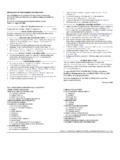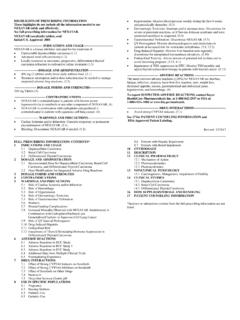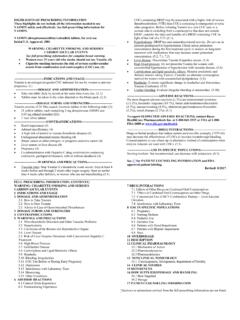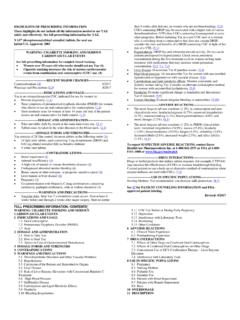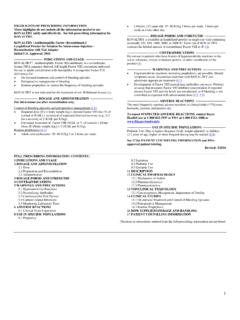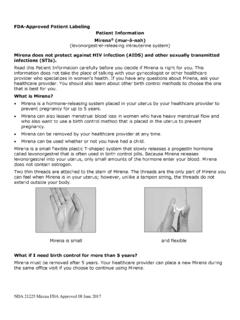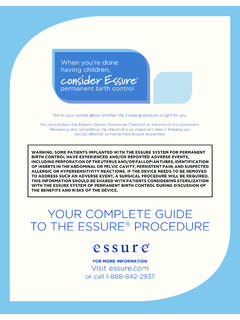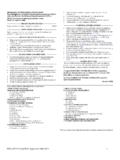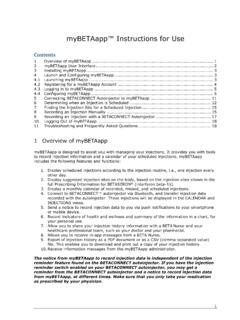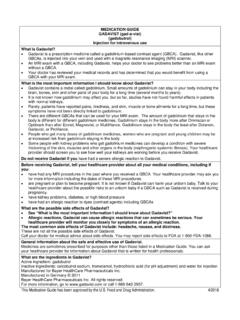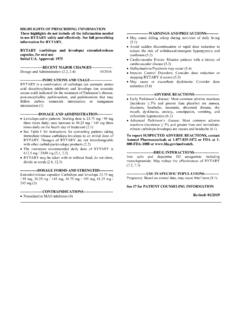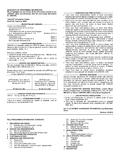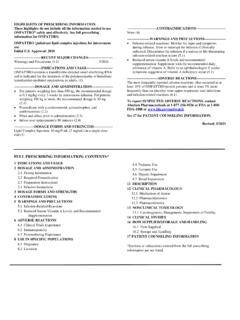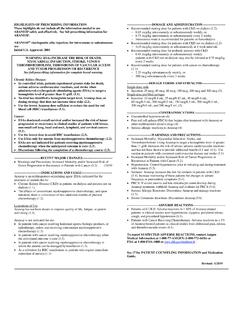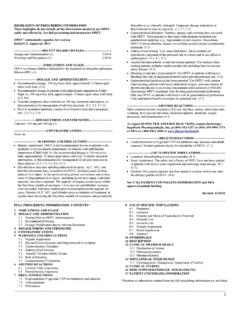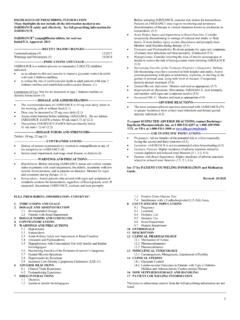Transcription of HIGHLIGHTS OF PRESCRIBING INFORMATION These …
1 NDA 21225 Mirena FDA Approved 08 June 2017 HIGHLIGHTS OF PRESCRIBING INFORMATION These HIGHLIGHTS do not include all the INFORMATION needed to use MIRENA safely and effectively. See full PRESCRIBING INFORMATION for MIRENA. MIRENA (levonorgestrel-releasing intrauterine system) Initial Approval: 2000 ----------------------------RECENT MAJOR CHANGES-------------------------- Indications and Usage, Mirena is recommended for women who have had at least one child. Removed (1) 6/2017 Dosage and Administration, Timing of insertion ( ) 5/2017 ----------------------------INDICATIONS AND USAGE--------------------------- Mirena is a progestin-containing intrauterine system indicated for: Intrauterine contraception for up to 5 years (1) Treatment of heavy menstrual bleeding for women who choose to use intrauterine contraception as their method of contraception.
2 (1) ----------------------DOSAGE AND ADMINISTRATION----------------------- Initial release rate of levonorgestrel (LNG) is 20 mcg/day; this rate is reduced by about 50% after 5 years; Mirena must be removed or replaced after 5 years. (2) To be inserted by a trained healthcare provider using strict aseptic technique. Follow insertion instructions exactly as described. ( ) Patient should be re-examined and evaluated 4 to 6 weeks after insertion; then, yearly or more often if indicated. ( ) ---------------------DOSAGE FORMS AND STRENGTHS---------------------- One sterile intrauterine system consisting of a T-shaped polyethylene frame with a steroid reservoir containing 52 mg levonorgestrel packaged within a sterile inserter (3) -------------------------------CONTRAIND ICATIONS------------------------------ Pregnancy or suspicion of pregnancy.
3 Cannot be used for post-coital contraception (4). Congenital or acquired uterine anomaly if it distorts the uterine cavity (4) Acute pelvic inflammatory disease (PID) or a history of PID unless there has been a subsequent intrauterine pregnancy (4) Postpartum endometritis or infected abortion in the past 3 months (4) Known or suspected uterine or cervical neoplasia (4) Known or suspected breast cancer or other progestin-sensitive cancer (4) Uterine bleeding of unknown etiology (4) Untreated acute cervicitis or vaginitis or other lower genital tract infections (4) Acute liver disease or liver tumor (benign or malignant) (4) Increased susceptibility to pelvic infection (4) A previous intrauterine device (IUD) that has not been removed (4) Hypersensitivity to any component of Mirena (4) -----------------------WARNINGS AND PRECAUTIONS------------------------ Remove Mirena if pregnancy occurs with Mirena in place.
4 If pregnancy occurs, there is increased risk of ectopic pregnancy including loss of fertility, pregnancy loss, septic abortion (including septicemia, shock and death), and premature labor and delivery. ( , ) Group A streptococcal infection has been reported; strict aseptic technique is essential during insertion. ( ) Before using Mirena, consider the risks of PID. ( ) Bleeding patterns become altered, may remain irregular and amenorrhea may ensue. ( ) Perforation may occur and may reduce contraceptive effectiveness. Risk is increased if inserted in lactating women and may be increased if inserted in women with fixed retroverted uteri and postpartum. ( ) Partial or complete expulsion may occur. ( ) Evaluate persistent enlarged ovarian follicles or ovarian cysts. ( ) ------------------------------ADVERSE REACTIONS------------------------------- The most common adverse reactions ( 10% users) are alterations of menstrual bleeding patterns, abdominal/pelvic pain, amenorrhea, headache/migraine, genital discharge, and vulvovaginitis.
5 ( ) To report SUSPECTED ADVERSE REACTIONS, contact Bayer HealthCare Pharmaceuticals Inc. at 1-888-842-2937 or FDA at 1-800-FDA-1088 or ------------------------------DRUG INTERACTIONS---------------------------- --- Drugs or herbal products that induce certain enzymes, such as CYP3A4, may decrease the serum concentration of progestins. (7) See 17 for PATIENT COUNSELING INFORMATION and FDA-approved patient labeling Revised: 6/2017 FULL PRESCRIBING INFORMATION : CONTENTS* 1 INDICATIONS AND USAGE 2 DOSAGE AND ADMINISTRATION Insertion Instructions Patient Follow-up Removal of Mirena Continuation of Contraception after Removal 3 DOSAGE FORMS AND STRENGTHS 4 CONTRAINDICATIONS 5 WARNINGS AND PRECAUTIONS Ectopic Pregnancy Intrauterine Pregnancy Sepsis Pelvic Infection Irregular Bleeding and Amenorrhea Perforation Expulsion Ovarian Cysts Breast Cancer Clinical Considerations for Use and Removal 6 ADVERSE REACTIONS Clinical Trials Experience Postmarketing Experience 7 DRUG INTERACTIONS 8 USE IN SPECIFIC POPULATIONS Pregnancy Lactation Pediatric Use Geriatric Use Hepatic Impairment Renal Impairment 11 DESCRIPTION Mirena Inserter 12 CLINICAL PHARMACOLOGY Mechanism of Action Pharmacodynamics Pharmacokinetics 13 NONCLINICAL TOXICOLOGY Carcinogenesis.
6 Mutagenesis, Impairment of Fertility 14 CLINICAL STUDIES Clinical Trials on Contraception Clinical Trial on Heavy Menstrual Bleeding 15 REFERENCES 16 HOW SUPPLIED/STORAGE AND HANDLING 17 PATIENT COUNSELING INFORMATION *Sections or subsections omitted from the full PRESCRIBING INFORMATION are not listed NDA 21225 Mirena FDA Approved 08 June 2017 FULL PRESCRIBING INFORMATION 1 INDICATIONS AND USAGE Mirena is indicated for intrauterine contraception for up to 5 years. Mirena is also indicated for the treatment of heavy menstrual bleeding in women who choose to use intrauterine contraception as their method of contraception. The system should be replaced after 5 years if continued use is desired. 2 DOSAGE AND ADMINISTRATION Mirena contains 52 mg of levonorgestrel (LNG). Initially, LNG is released at a rate of approximately 20 mcg/day.
7 This rate decreases progressively to half that value after 5 years. Mirena must be removed by the end of the fifth year and can be replaced at the time of removal with a new Mirena if continued contraceptive protection is desired. Mirena is supplied within an inserter in a sterile package (see Figure 1) that must not be opened until required for insertion [see Description ( )]. Do not use if the seal of the sterile package is broken or appears compromised. Use strict aseptic techniques throughout the insertion procedure [see Warnings and Precautions ( )]. Insertion Instructions A complete medical and social history should be obtained to determine conditions that might influence the selection of a levonorgestrel-releasing intrauterine system (LNG IUS) for contraception. If indicated, perform a physical examination, and appropriate tests for any forms of genital or other sexually transmitted infections.
8 [See Contraindications (4) and Warnings and Precautions ( ).] Follow the insertion instructions exactly as described in order to ensure proper placement and avoid premature release of Mirena from the inserter. Once released, Mirena cannot be re-loaded. NDA 21225 Mirena FDA Approved 08 June 2017 Mirena should be inserted by a trained healthcare provider. Healthcare providers should become thoroughly familiar with the insertion instructions before attempting insertion of Mirena. Insertion may be associated with some pain and/or bleeding or vasovagal reactions (for example, syncope, bradycardia), or with seizure in an epileptic patient, especially in patients with a predisposition to These symptoms. Consider administering analgesics prior to insertion. Timing of Insertion Table 1: When to Insert Mirena Starting Mirena in women not currently using hormonal or intrauterine contraception Mirena can be inserted any time the provider can be reasonably certain the woman is not pregnant.
9 Consider the possibility of ovulation and conception prior to initiation of this product [see Contraindications (4)]. If Mirena is inserted during the first seven days of the menstrual cycle or immediately after a first trimester abortion, back up contraception is not needed. If Mirena is not inserted during the first seven days of the menstrual cycle, a barrier method of contraception should be used or the patient should abstain from vaginal intercourse for seven days to prevent pregnancy. Switching to Mirena from an oral, transdermal or vaginal hormonal contraceptive Mirena may be inserted at any time, including during the hormone-free interval of the previous method. If inserted during active use of the previous method, continue that method for 7 days after Mirena insertion or until the end of the current treatment cycle. If the woman was using continuous hormonal contraception, discontinue that method seven days after Mirena insertion.
10 Switching to Mirena from an injectable progestin contraceptive Mirena may be inserted at any time; a back-up method of contraception (such as condoms or spermicide) should also be used for 7 days if Mirena is inserted more than 3 months (13 weeks) after the last injection. Switching to Mirena from a contraceptive implant or another IUS Insert Mirena on the same day the implant or IUS is removed. Mirena may be inserted at any time during the menstrual cycle. Inserting Mirena after abortion or miscarriage First-trimester Mirena may be inserted immediately after a first-trimester abortion or miscarriage. Second-trimester Do not insert Mirena until a minimum of 6 weeks after second trimester abortion or miscarriage, or until the uterus is fully involuted. If involution is delayed, wait until involution is complete before insertion [see Warnings and Precautions ( , )].
